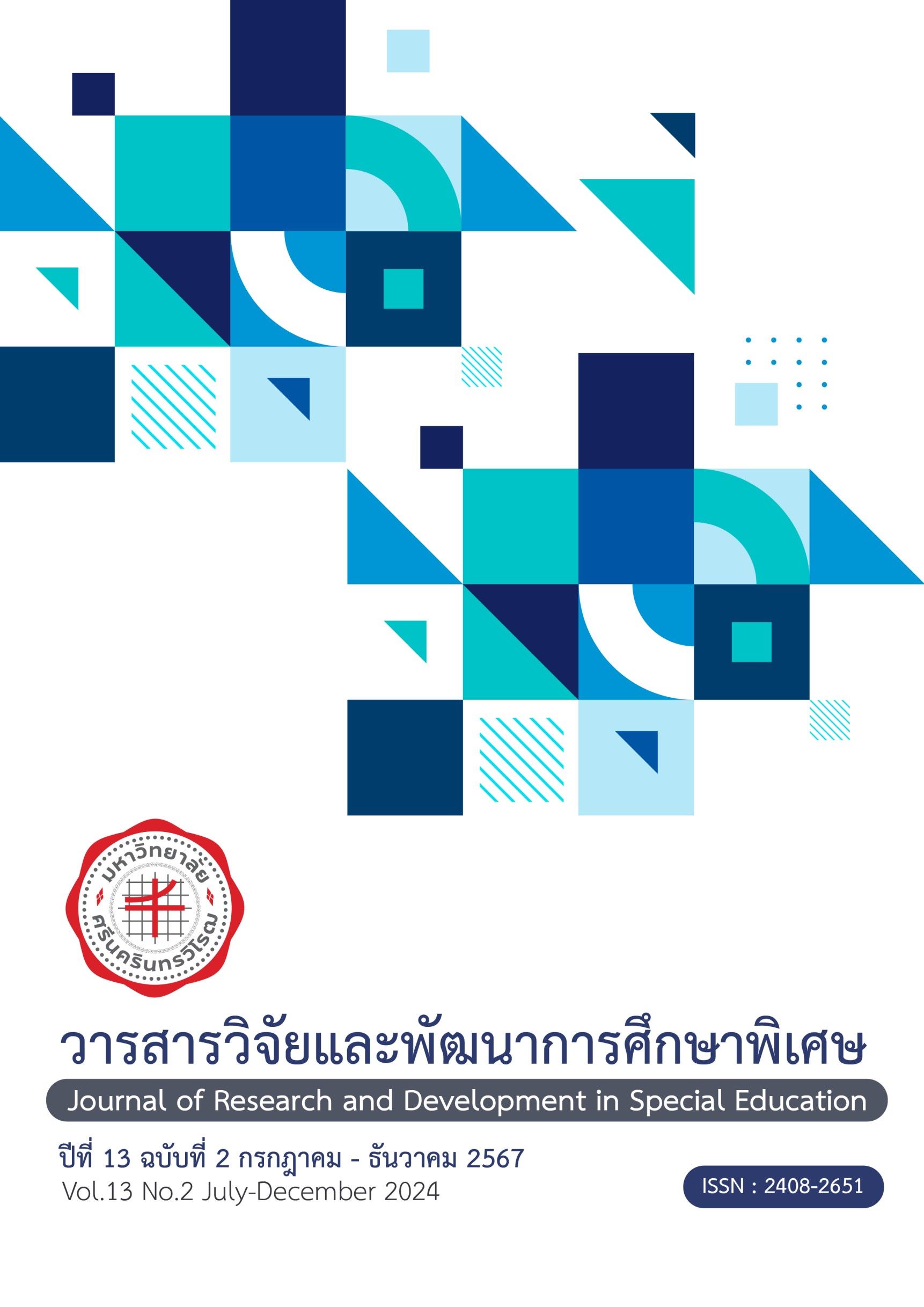ผลของกระบวนการฝึกการสื่อสารตามธรรมชาติต่อทักษะการสื่อสารของเด็กออทิสติก ระดับเตรียมความพร้อม ในศูนย์การศึกษาพิเศษ
Keywords:
เด็กออทิสติก, ทักษะการสื่อสาร, การฝึกการสื่อสารตามธรรมชาติAbstract
การศึกษาครั้งนี้เป็นการวิจัยแบบกลุ่มตัวอย่างเดี่ยว (Single Subject Design) มีวัตถุประสงค์เพื่อศึกษาผลของกระบวนการฝึกการสื่อสารตามธรรมชาติ (FCT) ต่อทักษะการสื่อสารของเด็กออทิสติก ระดับเตรียมความพร้อม ในศูนย์การศึกษาพิเศษ เด็กออทิสติกเป้าหมายคือเด็กออทิสติก 1 คน เพศหญิง อายุ 6 ปี เครื่องมือที่ใช้ในการวิจัยประกอบด้วย 1. ชุดเครื่องมือบันทึกข้อมูลการประเมินพฤติกรรมการทำหน้าที่ (FBA) 2. แบบสังเกตความถี่พฤติกรรมปัญหา 3. แบบสังเกตการพูดหรือใช้ท่าทางปฏิเสธ และ 4. แผนการสนับสนุนพฤติกรรมเชิงบวกโดยใช้กระบวนการฝึกการสื่อสารตามธรรมชาติ เด็กออทิสติกเป้าหมายเข้ารับการฝึกทั้งหมด 5 สัปดาห์ สัปดาห์ละ 3 ครั้ง รวมทั้งหมด 15 ครั้ง วิเคราะห์ความสามารถในการใช้ทักษะการสื่อสารของเด็กออทิสติก โดยนำข้อมูลความถี่มาเปรียบเทียบและพรรณนาความสามารถในการนำทักษะการสื่อสารไปใช้ในสถานการณ์ต่าง ๆ ของเด็กออทิสติก นำเสนอผ่านการบรรยายเชิงพรรณาและกราฟเส้นเพื่อเปรียบเทียบข้อมูลทักษะการสื่อสารระยะเส้นฐานกับระยะเก็บรวบรวมข้อมูล ผลการศึกษาพบว่า เมื่อได้รับการฝึกด้วยกระบวนการฝึกการสื่อสารตามธรรมชาติ (FCT) ส่งผลให้เด็กออทิสติกมีทักษะการสื่อสารสูงขึ้นDownloads
References
กุลยา ก่อสุวรรณ และ ยุวดี วิริยางกูร. (2562). ออทิสติก สอนไม่ยาก หากเข้าใจ: โรงพิมพ์พลีโอมีเดียดีไซน์.
งานข้อมูลและสารสนเทศ สำนักบริหารงานการศึกษาพิเศษ. (2565). รายงานจำนวนนักเรียนแยกตามประเภทการให้บริการ ศูนย์การศึกษาพิเศษ ประจำจังหวัดสระบุรี ประจำปีการศึกษา 2565.
แก้วตา นพมณีจำรัสเลิศ และ อินทร์สุดา แก้วกาญจน์. (2560). กระบวนทัศน์ใหม่การดูแลรักษาเด็กออทิสติกสำหรับกุมารแพทย์. วารสารกุมารเวชศาสตร์, 56(1), 6-15. สืบค้นจาก https://cf.mahidol.ac.th/th/wp-content/uploads/2019/08/new-paradigm.pdf
AFIRM Team. (2017). Functional communication training. NC: National Professional Development Center on Autism Spectrum Disorders. Retrieved from http://afirm.fpg.unc.edu/Functional_communication_training
Alakhzami, M. N. (2020). Using Functional Communication Training to Reduce Self-Injurious Behavior for Individuals with Autism Spectrum Disorder. (PhD Doctoral dissertation). Duquesne University, Retrieved from https://dsc.duq.edu/etd/1904
Autism Speaks Inc. (2018). Autism and Challenging Behaviors: Strategies and Support. Retrieved from https://www.autismspeaks.org/sites/default/files/2018-08/Challenging%20Behaviors%20Tool%20Kit.pdf
Brown, C. J. & Hickman C. (2017). Functional Communication Training to Reduce Maladaptive Behaviors During Self-Care Routines. Journal of Community-Based Practice in Applied Behavior Analysis (JCPABA).
Bruhn et al. (2015). Assessing and Treating Stereotypical Behaviors in Classrooms Using a Functional Approach. Behavioral Disorders, 41(1), 21-37. doi:10.17988/0198-7429-41.1.21
Collins, T. (2010). Functional Communication Training to Increase Communication Skills for Young Children with Autism Spectrum Disorder. (Doctor of Philosophy (PhD) Dissertation). Clemson University, the Graduate School of Clemson University. Retrieved from https://tigerprints.clemson.edu/all_dissertations/582/
Franzone, E. (2009a). Overview of functional communication training (FCT). WI, National Professional Development Center on Autism Spectrum Disorders. Retrieved from https://csesa.fpg.unc.edu/sites/csesa.fpg.unc.edu/files/ebpbriefs/FCT_Overview_0.pdf
Franzone, E. (2009b). Steps for implementation: Functional communication training. WI, National Professional Development Center on Autism Spectrum Disorders. Retrieved from https://autismpdc.fpg.unc.edu/sites/autismpdc.fpg.unc.edu/files/FCT_Steps_0.pdf
Fuller, E. A., & Kaiser, A. P. (2020). The Effects of Early Intervention on Social Communication Outcomes for Children with Autism Spectrum Disorder: A Meta-analysis. J Autism Dev Disord, 50(5), 1683-1700. doi:10.1007/s10803-019-03927-z
Hieneman, M. (2015). Positive Behavior Support for Individuals with Behavior Challenges. Behavior Analysis in Practice, 8(1), 101-108. doi:10.1007/s40617-015-0051-6
Hutchins, T. L., & Prelock, P. A. (2014). Using communication to reduce challenging behaviors in individuals with autism spectrum disorders and intellectual disability. Child Adolesc Psychiatr Clin N Am, 23(1), 41-55. doi:10.1016/j.chc. 2013.07.003
Ismiarti, R., & Rohmad, Z. (2019). Communication Abilities of Autistic Children in Social Interaction. International Journal of Educational Research Review, 4, 172-177. doi:10.24331/ijere.517993
NIDCD. (2020). Autism Spectrum Disorder: Communication problems in children. NIH, 97. Retrieved from https://www.nidcd.nih.gov/sites/default/files/Documents/health/voice/AutismSpectrumDisorder-508.pdf
Mirenda, P. & Iacono, T. (2009). Autism Spectrum Disorders and AAC. Baltimore, MD: Paul H. Brookes.
Runcan, P. L., Constantineanu, C., Ielics, B., & Popa, D. (2012). The Role of Communication in the Parent-Child Interaction. Procedia - Social and Behavioral Sciences, 46, 904-908. doi:https://doi.org/10.1016/j.sbspro.2012.05.221
Roby, E. N. (2016). The Effects of Functional Communication Training on the Emission of Independent Mands and Reduction of Problem Behaviors in Children Diagnosed with Autism Spectrum Disorder. The Ohio State University, Retrieved from https://etd.ohiolink.edu/apexprod/rws_etd/send_file/send?accession=osu1462727736&disposition=inline




